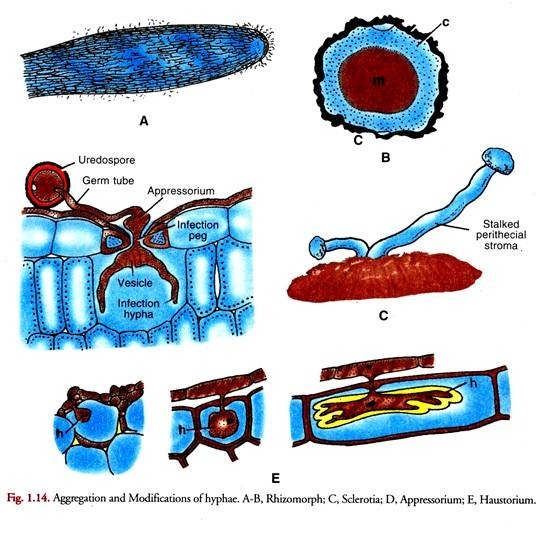ADVERTISEMENTS:
In this article we will discuss about the evolution of thallus in lower fungi with the help of diagrams.
In the simplest and primitive members, which are aquatic, there is no mycelium. The thallus in these forms is microscopic and unicellular. In Olpidium endogenum, it consists of a tiny mass of naked, uninucleate protoplast which enters the host cell, enlarges and lays down a cell wall of chitin (A1).
At the reproductive stage, the entire cell protoplast is involved in zoospore formation (A2). In the more advanced unicellular forms the thallus is fixed to the substratum by a few thin, hair-like structures, the rhizoids (B1).
The coenocytic thallus is holocarpic. At maturity, it is converted either into a single reproductive organ (zoosporangium or gametangium) as in family Olpidiaceae (B2) or into a cluster of such organs (family Synchytriaceae).
Some more advanced aquatic members have a little more complex vegetative body. It may consist of two multinucleate compartments. One of these is vegetative in function and the other reproductive (C).
Blastocladiella is an example. The gametothallus of Allomyces which is a soil dwelling fungus consists of branched, multinucleate hyphae forming a small mycelium.
It comprises of:
ADVERTISEMENTS:
(i) A group of rhizoids which fixed the thallus to the substratum,
(ii) A short, slender trunk-like body bearing,
(iii) Dichotomously branched hyphae (D). The latter bear the sex organs.
The vast majority of the Lower Fungi (Phycomycetes), aquatic as well as terrestrial, have a well-developed, filamentous thallus, celled the mycelium. It is differentiated into distinct, sterile and fertile portions and thus is eucarpic (E). The eucarpic mycelium is of two types. In one type, the mycelium is differentiated into an aerial portion and holdfast (Rhizopus). The holdfast is branched and tapering (E).
It penetrates the substratum. The aerial portion consists of usually stout, cylindrical, branched and coenocytic aseptate hyphae. In the second type the mycelium (as in Peronosporales) consists of slender, cylindrical, coenocytic hyphae which grow hidden from view within the tissues of the host (Fig- 1.14D) or in dead organic matter in the soil or water.
The hyphae in the mycelium of majority of the species, are coenocytic and aseptate. The septa usually remain suppressed in the actively growing mycelium. They are, however, not totally absent. They appear in the older hyphae of some species. In a few species they have been reported to be formed regularly by the young hyphae.
However, these septa do not form complete partitions. In the majority of cases, they have a central pore. The septa also appear in connection with the formation of the reproductive organs and also to seal a damaged portion of hypha. In the latter cases the septa are complete partitions. They are solid, plate-like structures.
The filamentous Lower Fungi (Phycomycetes) can be arranged in a series illustrating a progressive transition from an aquatic to a terrestrial mode of life through the amphibious way of life. The series starts with Saprolegnia at the lower end. It is a saprophytic water mold.
ADVERTISEMENTS:
It grows in calm fresh water and also in well-irrigated soils. Pythium is a little more soil-minded. More often it grows in damp soil than in water. However, they both produce zoospores. This shows that basically they are aquatic types.
Phytophthora is a distinctly amphibious type. Under normal conditions, the fungal mycelium bears sporangia which develop zoospores. But under adverse circumstances which do not permit dispersal by zoospores such as lack of free water or too high a temperature, the sporangia get detached and behave like conidia. The conidia are dispersed by wind.
On germination, the conidium directly produces a germ tube which grows into a new fungus mycelium. Similarly, a species of Plasmopara which is a causative agent of downy mildew disease of grapes is amphibious. It can adjust itself to both terrestrial and aquatic habitats.
In the former case the sporangia behave as conidia and in the liter case, they produce zoospores. On the other hand, a species of Peronospora (P. destructor) downy mildew disease in onions is fully terrestrial. It produces sporangia which invariably function as conidia and grow by putting out germ tubes.
ADVERTISEMENTS:
Mucorales which are the most advance members of the Lower Fungi (Phycomycetes) are strictly terrestrial. They bear sporangia in which are produced non-motile, encapsulated, wind- disseminated sporangiospores—an adaptation to a terrestrial mode of life.
The sporangiospore has a wall which makes it more resistant to drying and other unfavourable conditions (high or low temperature) than the zoospores. It can survive for some period while being blown about in the air till the time it falls on a suitable soil where it can germinate to give rise to a new plant.


